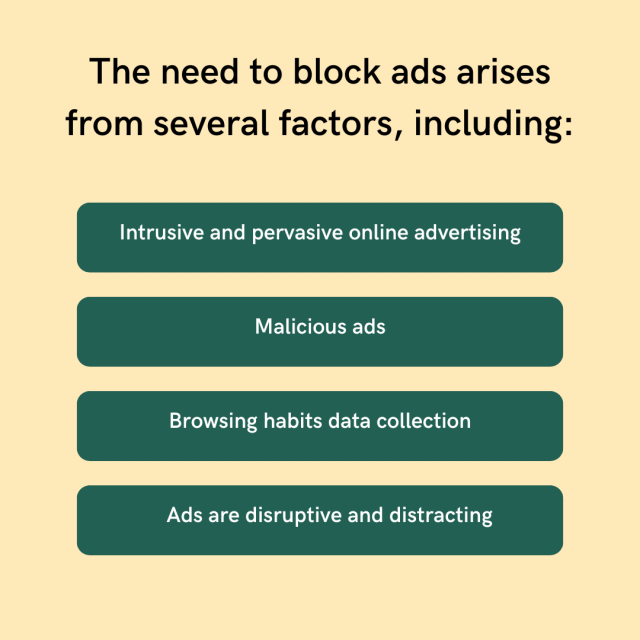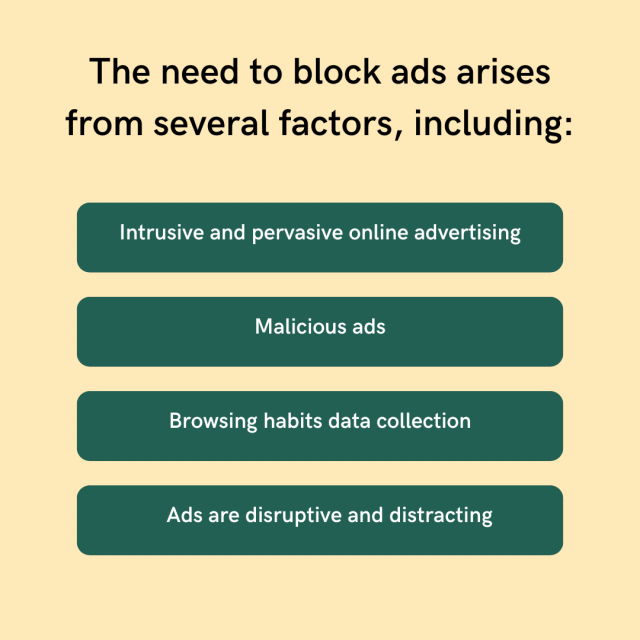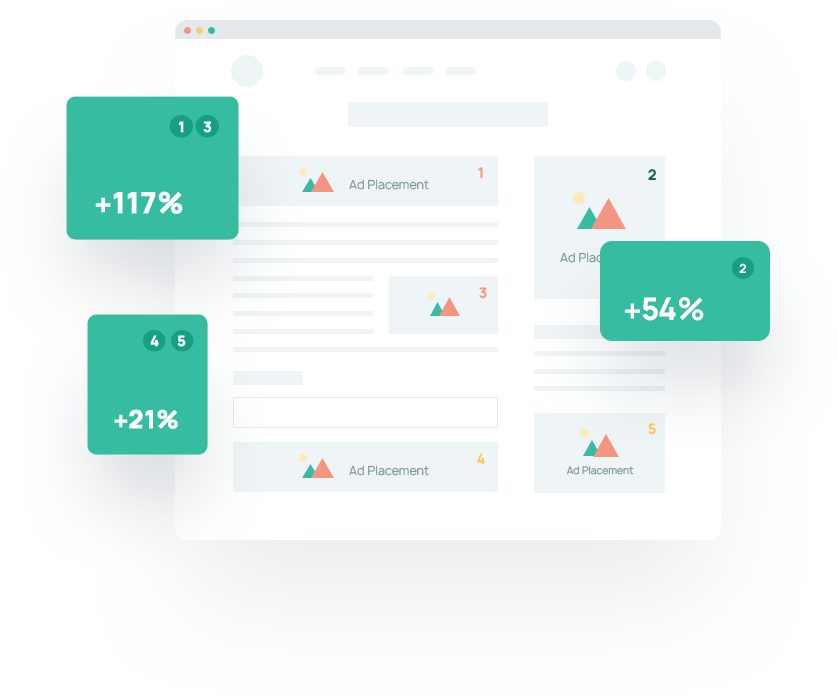In today’s competitive digital landscape, creating effective ads is crucial to the success of any marketing campaign. It’s essential to ensure that your ad pages are attractive and efficient.
As an ad testing company, we block ads during the testing process to ensure that the results obtained from the testing are accurate and unbiased. We also block ads to prevent ad fraud.
Ad fraud occurs when bots or malicious software imitate human activity and generate fake clicks or impressions on ads. Adblock testers prevent ad fraud and ensure that the results and metrics obtained from the testing are valid.
Adblock also reduces the impact of external factors affecting ad performance, such as ad blockers, browser settings, and network latency, affecting ad performance. It ensures that the test results are based solely on the ad getting tested and not on external factors.
Determining which ad will resonate best with your target audience can be challenging. That’s where ad page testing comes in. Ad testing refers to the process of evaluating the effectiveness of advertising campaigns.
It involves various methods, such as gathering feedback from target audiences or conducting surveys to assess the ad’s impact on brand awareness, purchase intent, or overall customer perception. Ad testing helps advertisers optimize their campaigns by identifying strengths and weaknesses and adjusting their messaging, design, or targeting strategies accordingly.
Ad page testing helps you evaluate your ad page’s performance and identify improvement areas. Here is an efficient guide to the entire process of conducting an ad page test.
Why Do We Need To Block Ads?

Firstly, online advertising has become increasingly pervasive and intrusive, appearing on almost every website and platform. It has led to users getting bombarded with ads on browsers like Chrome, often irrelevant to their interests, which slow down the performance of their devices and computers.
Additionally, some ads are malicious, containing malware or phishing scams that harm users’ devices or compromise their personal information.

Secondly, online advertising collects user browsing habits data, which can get sold to third-party companies without the user’s knowledge or consent. It raises serious privacy concerns, as users’ personal information is tracked and shared without permission.
Additionally, many users find ads annoying, disruptive, and distracting from the content they are trying to consume. Ads interrupt videos, pop up in the middle of articles, and take up valuable screen real estate. They frustrate users who pay for ad-free versions of websites or apps only to be bombarded with ads anyway.
For these reasons, many users configure ad-blockers to improve their online experience, protect their privacy, and reduce the number of unwanted ads they encounter. While there are legitimate uses of online advertising, it is clear that the current state of online advertising needs reform to address these issues and better serve users’ needs.
Different ad placements and formats get tested during an ad website test to determine which ones perform the best. Testing may involve running ads from various advertisers or networks or testing different ad creatives to see which are more effective at capturing users’ attention and driving clicks.
In 2015, Apple introduced the ability for users of its iOS devices to install content blockers as an add-on. Content blockers are available as third-party apps from the App Store, and can also get integrated into Safari, the default web browser for iOS devices through HTML.
AdSense advertising platform, operated by Google, allows website publishers and bloggers to earn revenue by displaying relevant website ads. When a visitor clicks on an ad, the publisher makes some of the advertiser’s revenue. Through an AdSense test, contextual targeting technology matches ads with the website’s content.
What Do Ad Page Tests Show and What Is the Purpose?
Ad page tests compare two or more versions of a test page, email, or advertisement, such as Google Ads, to determine which one performs better. These tests are commonly used in digital marketing to optimize a website’s or advertisement’s conversion rate. Ad page tests aim to identify which version of the advertisement or landing page leads to higher engagement and conversions.
By creating two or more versions of an ad or web page and randomly showing them to visitors, marketers can ad-check the performance of each ad version based on various metrics, such as click-through rate, bounce rate, time on page, and conversion rate.
Ad page tests help marketers improve the effectiveness of their campaigns by identifying the most effective elements, such as headlines, images, calls-to-action, and layouts. By using the insights gained from ad page testing, marketers refine their advertising strategies and create more effective campaigns that generate a higher return on investment (ROI).

AdBlock Plus
The AdBlock Plus test tool has a built-in feature to check if your ad blocker works. The extension works by blocking an ads page test on web pages using a list of filters.
These filters are essentially rules that AdBlock Plus uses to determine which ads to block. Users can also create custom filters to block specific ads or elements on a webpage.
AdBlock
AdBlock is also a browser extension that allows users to block online ads while browsing the internet. It uses a combination of filters and rules to block ads from loading on web pages.
When a user visits a website, AdBlock scans the page for any ads that match its filter lists and block them from loading. The process improves the user’s browsing experience by speeding up page load times, reducing clutter, and eliminating annoying or intrusive ads.
AdBlocker Ultimate
AdBlocker Ultimate is a free and open-source browser extension that aims to block all online advertisements, including banners, pop-ups, and video ads. It uses advanced algorithms to detect and block ads, tracking scripts, and other forms of online trackers. It also protects operating systems from malware and phishing attacks by blocking malicious websites.
AdGuard
AdGuard is a popular ad-blocking software that helps users block ads, pop-ups, and other unwanted content while browsing the internet. It uses a variety of filters and rules to block ads, including a comprehensive ad-blocking list, a social media filter, a phishing filter, and more.
How To Test for Pi-Hole?
Pi-Hole is a DNS sinkhole that blocks ads, trackers, and other unwanted network traffic on your local network. You must install an operating system like Raspberry Pi or any other Linux-based device.
Before You Test
Before testing Pi-Hole, it is essential to ensure it is running correctly. To start with Pi-hole, install the software on a compatible device, such as a Raspberry Pi. You can then configure Pi-hole to act as your network’s DNS server, allowing it to intercept and filter DNS requests from your devices.
Depending on your specific setup and preferences, many online guides can help you install and configure Pi-hole. Testing Pi-Hole is essential to ensure it works correctly and effectively blocks unwanted traffic on your network.
Pi-Hole comes with a web interface that allows you to monitor the status of the Pi-Hole server and view the domains it is blocking. You can access the Pi-Hole web interface by typing the IP address of the Pi-Hole server in your web browser. If Pi-Hole runs correctly, you should see the Pi-Hole dashboard showing the number of ads and trackers blocked on your network.
How To Test for Pi-Hole
To test Pi-Hole using a web browser, you can visit a website with ads or trackers. If Pi-Hole is blocking ads and trackers correctly, you should not see any ads or trackers on the website. You can also perform ad testing on Pi-Hole using the Pi-Hole debug tool, which allows you to check if Pi-Hole resolves DNS queries correctly.
Checking its DNS resolution can verify that Pi-Hole is blocking ads and trackers. If Pi-Hole is working correctly, it should return the IP address of the Pi-Hole server instead of the IP address of the domain.
Testing for Pi-hole can be more complicated if you’re using a VPN. The first step is to ensure that your VPN configuration is correct to allow access to your local network. Pi-hole typically runs on a local server, and you need to be able to access it to test it. You can check this by pinging the Pi-hole server from your device while connected to the VPN.
Once you’ve confirmed that you can access the Pi-hole server, the next step is to test whether Pi-hole is blocking ads and trackers. One way to do this is to visit a website that displays ads or trackers, such as an ad-heavy news site. If Pi-hole is working correctly, you should see a significant reduction in ads and trackers displayed on the site.
How Do You Know if Ad Blockers Work?
There are a few ways to determine whether an ad blocker, such as AdGuard, works for an operating system. The most obvious way is to visit a website or use an app that typically displays ads and see if the ads are blocked. The ad blocker works as intended if the ads fail to show on websites like Safari, Microsoft Edge, and Yahoo.
Another way to verify the plugin’s functionality is to check the network traffic using a wifi analyzer tool such as Wireshark. When an ad blocker is active, it should prevent requests for ad content from being sent to ad servers. By analyzing the network traffic, it is possible to determine whether ad requests are getting blocked or not.
Additionally, some ad blockers provide statistics or logs of the blocked ads. It is a helpful way to see how many ads have got blocked and where they originated. Some ad blockers also provide customization options that allow users to select which types of ads to block or whitelist specific websites.
However, some websites with ads tests and apps may detect the use of ad blockers and attempt to prevent them from working. Sometimes, users may need to disable their ad blocker or use alternative methods to access their desired content.
Some ads have a design programmed through JavaScript, so they do not trigger these filters. For example, acceptable ads are deemed non-intrusive by the adblocker software company. These ads are typically smaller and less flashy than traditional banner ads and do not contain animations or sound.
They also appear in areas less likely to interfere with the website user experience, such as in the sidebar.
Other ads that may be deemed acceptable by adblockers include native ads. They blend in with the surrounding content and appear less like traditional ads. Additionally, contextual ads target users’ interests based on their browsing history or search queries.
Depending on the specific ad blocker software and the web browser under use, the icon indicating that the ad blocker is active may appear in different locations. However, it’s common for the icon to appear in the search bar or the top-right corner of the browser window.
When the ad blocker icon is active, it indicates it is working to prevent ads and other unwanted content from loading on the current webpage.
Conclusion
Ad page testing compares two versions of a web page or ad to determine which one performs better. Ad testing aims to optimize the overall effectiveness of the page or ad by increasing conversion or search engine click-through rates.
In today’s competitive digital landscape, creating effective ads is crucial to the success of any marketing campaign. It’s essential to ensure that your ad pages are attractive and efficient.
As an ad testing company, we block ads during the testing process to ensure that the results obtained from the testing are accurate and unbiased. We also block ads to prevent ad fraud.
Ad fraud occurs when bots or malicious software imitate human activity and generate fake clicks or impressions on ads. Adblock testers prevent ad fraud and ensure that the results and metrics obtained from the testing are valid.
Adblock also reduces the impact of external factors affecting ad performance, such as ad blockers, browser settings, and network latency, affecting ad performance. It ensures that the test results are based solely on the ad getting tested and not on external factors.
Determining which ad will resonate best with your target audience can be challenging. That’s where ad page testing comes in. Ad testing refers to the process of evaluating the effectiveness of advertising campaigns.
It involves various methods, such as gathering feedback from target audiences or conducting surveys to assess the ad’s impact on brand awareness, purchase intent, or overall customer perception. Ad testing helps advertisers optimize their campaigns by identifying strengths and weaknesses and adjusting their messaging, design, or targeting strategies accordingly.
Ad page testing helps you evaluate your ad page’s performance and identify improvement areas. Here is an efficient guide to the entire process of conducting an ad page test.
Why Do We Need To Block Ads?

Firstly, online advertising has become increasingly pervasive and intrusive, appearing on almost every website and platform. It has led to users getting bombarded with ads on browsers like Chrome, often irrelevant to their interests, which slow down the performance of their devices and computers.
Additionally, some ads are malicious, containing malware or phishing scams that harm users’ devices or compromise their personal information.

Secondly, online advertising collects user browsing habits data, which can get sold to third-party companies without the user’s knowledge or consent. It raises serious privacy concerns, as users’ personal information is tracked and shared without permission.
Additionally, many users find ads annoying, disruptive, and distracting from the content they are trying to consume. Ads interrupt videos, pop up in the middle of articles, and take up valuable screen real estate. They frustrate users who pay for ad-free versions of websites or apps only to be bombarded with ads anyway.
For these reasons, many users configure ad-blockers to improve their online experience, protect their privacy, and reduce the number of unwanted ads they encounter. While there are legitimate uses of online advertising, it is clear that the current state of online advertising needs reform to address these issues and better serve users’ needs.
Different ad placements and formats get tested during an ad website test to determine which ones perform the best. Testing may involve running ads from various advertisers or networks or testing different ad creatives to see which are more effective at capturing users’ attention and driving clicks.
In 2015, Apple introduced the ability for users of its iOS devices to install content blockers as an add-on. Content blockers are available as third-party apps from the App Store, and can also get integrated into Safari, the default web browser for iOS devices through HTML.
AdSense advertising platform, operated by Google, allows website publishers and bloggers to earn revenue by displaying relevant website ads. When a visitor clicks on an ad, the publisher makes some of the advertiser’s revenue. Through an AdSense test, contextual targeting technology matches ads with the website’s content.
What Do Ad Page Tests Show and What Is the Purpose?
Ad page tests compare two or more versions of a test page, email, or advertisement, such as Google Ads, to determine which one performs better. These tests are commonly used in digital marketing to optimize a website’s or advertisement’s conversion rate. Ad page tests aim to identify which version of the advertisement or landing page leads to higher engagement and conversions.
By creating two or more versions of an ad or web page and randomly showing them to visitors, marketers can ad-check the performance of each ad version based on various metrics, such as click-through rate, bounce rate, time on page, and conversion rate.
Ad page tests help marketers improve the effectiveness of their campaigns by identifying the most effective elements, such as headlines, images, calls-to-action, and layouts. By using the insights gained from ad page testing, marketers refine their advertising strategies and create more effective campaigns that generate a higher return on investment (ROI).

AdBlock Plus
The AdBlock Plus test tool has a built-in feature to check if your ad blocker works. The extension works by blocking an ads page test on web pages using a list of filters.
These filters are essentially rules that AdBlock Plus uses to determine which ads to block. Users can also create custom filters to block specific ads or elements on a webpage.
AdBlock
AdBlock is also a browser extension that allows users to block online ads while browsing the internet. It uses a combination of filters and rules to block ads from loading on web pages.
When a user visits a website, AdBlock scans the page for any ads that match its filter lists and block them from loading. The process improves the user’s browsing experience by speeding up page load times, reducing clutter, and eliminating annoying or intrusive ads.
AdBlocker Ultimate
AdBlocker Ultimate is a free and open-source browser extension that aims to block all online advertisements, including banners, pop-ups, and video ads. It uses advanced algorithms to detect and block ads, tracking scripts, and other forms of online trackers. It also protects operating systems from malware and phishing attacks by blocking malicious websites.
AdGuard
AdGuard is a popular ad-blocking software that helps users block ads, pop-ups, and other unwanted content while browsing the internet. It uses a variety of filters and rules to block ads, including a comprehensive ad-blocking list, a social media filter, a phishing filter, and more.
How To Test for Pi-Hole?
Pi-Hole is a DNS sinkhole that blocks ads, trackers, and other unwanted network traffic on your local network. You must install an operating system like Raspberry Pi or any other Linux-based device.
Before You Test
Before testing Pi-Hole, it is essential to ensure it is running correctly. To start with Pi-hole, install the software on a compatible device, such as a Raspberry Pi. You can then configure Pi-hole to act as your network’s DNS server, allowing it to intercept and filter DNS requests from your devices.
Depending on your specific setup and preferences, many online guides can help you install and configure Pi-hole. Testing Pi-Hole is essential to ensure it works correctly and effectively blocks unwanted traffic on your network.
Pi-Hole comes with a web interface that allows you to monitor the status of the Pi-Hole server and view the domains it is blocking. You can access the Pi-Hole web interface by typing the IP address of the Pi-Hole server in your web browser. If Pi-Hole runs correctly, you should see the Pi-Hole dashboard showing the number of ads and trackers blocked on your network.
How To Test for Pi-Hole
To test Pi-Hole using a web browser, you can visit a website with ads or trackers. If Pi-Hole is blocking ads and trackers correctly, you should not see any ads or trackers on the website. You can also perform ad testing on Pi-Hole using the Pi-Hole debug tool, which allows you to check if Pi-Hole resolves DNS queries correctly.
Checking its DNS resolution can verify that Pi-Hole is blocking ads and trackers. If Pi-Hole is working correctly, it should return the IP address of the Pi-Hole server instead of the IP address of the domain.
Testing for Pi-hole can be more complicated if you’re using a VPN. The first step is to ensure that your VPN configuration is correct to allow access to your local network. Pi-hole typically runs on a local server, and you need to be able to access it to test it. You can check this by pinging the Pi-hole server from your device while connected to the VPN.
Once you’ve confirmed that you can access the Pi-hole server, the next step is to test whether Pi-hole is blocking ads and trackers. One way to do this is to visit a website that displays ads or trackers, such as an ad-heavy news site. If Pi-hole is working correctly, you should see a significant reduction in ads and trackers displayed on the site.
How Do You Know if Ad Blockers Work?
There are a few ways to determine whether an ad blocker, such as AdGuard, works for an operating system. The most obvious way is to visit a website or use an app that typically displays ads and see if the ads are blocked. The ad blocker works as intended if the ads fail to show on websites like Safari, Microsoft Edge, and Yahoo.
Another way to verify the plugin’s functionality is to check the network traffic using a wifi analyzer tool such as Wireshark. When an ad blocker is active, it should prevent requests for ad content from being sent to ad servers. By analyzing the network traffic, it is possible to determine whether ad requests are getting blocked or not.
Additionally, some ad blockers provide statistics or logs of the blocked ads. It is a helpful way to see how many ads have got blocked and where they originated. Some ad blockers also provide customization options that allow users to select which types of ads to block or whitelist specific websites.
However, some websites with ads tests and apps may detect the use of ad blockers and attempt to prevent them from working. Sometimes, users may need to disable their ad blocker or use alternative methods to access their desired content.
Some ads have a design programmed through JavaScript, so they do not trigger these filters. For example, acceptable ads are deemed non-intrusive by the adblocker software company. These ads are typically smaller and less flashy than traditional banner ads and do not contain animations or sound.
They also appear in areas less likely to interfere with the website user experience, such as in the sidebar.
Other ads that may be deemed acceptable by adblockers include native ads. They blend in with the surrounding content and appear less like traditional ads. Additionally, contextual ads target users’ interests based on their browsing history or search queries.
Depending on the specific ad blocker software and the web browser under use, the icon indicating that the ad blocker is active may appear in different locations. However, it’s common for the icon to appear in the search bar or the top-right corner of the browser window.
When the ad blocker icon is active, it indicates it is working to prevent ads and other unwanted content from loading on the current webpage.
Conclusion
Ad page testing compares two versions of a web page or ad to determine which one performs better. Ad testing aims to optimize the overall effectiveness of the page or ad by increasing conversion or search engine click-through rates.
In ad page testing, two different versions of the page or ad get shown to a sample of visitors, with each version featuring a different design or layout, headline, or call-to-action. The performance of each version is measured based on metrics such as conversion rate, click-through rate, bounce rate, and engagement rate.
The version that performs better gets selected as the new default version. People may choose to block ads for a variety of reasons. One reason is that ads can be annoying or intrusive, disrupting the browsing experience and slowing down page load times.
Additionally, some ads may be irrelevant or offensive to users, leading them to block ads to avoid such content. Some users may also be concerned about their privacy and security and may choose to block ads to prevent tracking or collecting personal information.
However, blocking ads can negatively affect publishers and advertisers, who rely on ad revenue to fund their websites and businesses. Blocking ads can also limit the availability of free content online, as many publishers offer their content for free in exchange for ad revenue.
As such, users need to weigh the benefits and drawbacks of blocking ads and consider supporting websites and publishers in other ways, such as through donations or subscriptions.
In ad page testing, two different versions of the page or ad get shown to a sample of visitors, with each version featuring a different design or layout, headline, or call-to-action. The performance of each version is measured based on metrics such as conversion rate, click-through rate, bounce rate, and engagement rate.
The version that performs better gets selected as the new default version. People may choose to block ads for a variety of reasons. One reason is that ads can be annoying or intrusive, disrupting the browsing experience and slowing down page load times.
Additionally, some ads may be irrelevant or offensive to users, leading them to block ads to avoid such content. Some users may also be concerned about their privacy and security and may choose to block ads to prevent tracking or collecting personal information.
However, blocking ads can negatively affect publishers and advertisers, who rely on ad revenue to fund their websites and businesses. Blocking ads can also limit the availability of free content online, as many publishers offer their content for free in exchange for ad revenue.
As such, users need to weigh the benefits and drawbacks of blocking ads and consider supporting websites and publishers in other ways, such as through donations or subscriptions.

